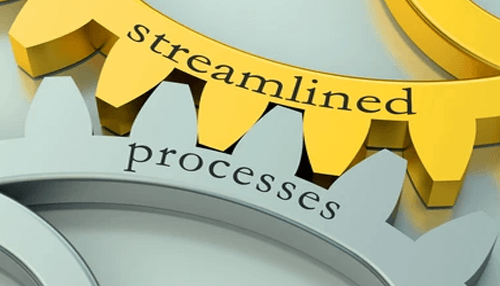Everyone has a process:
You have a process for getting up in the morning, for example — and though it might not always be efficient (especially without the morning Joe), it is a process nonetheless. In the same way, every business has a process (or processes plural, in many cases) that gets them to provide or produce their main offerings. But not every business has processes set up to perform optimally: like your morning routine, there are times when these processes even prove inefficient.
But you can make it better by streamlining your process! Read the ten tips below to learn how to make sure your streamlining efforts are all the more successful.
1. Get Familiar
It’s not a new concept, and you’ll hear about it ’til the cows come home: you have to know your process inside and out. Your business is dependent on this workflow, and the only way to find the kinks, investigate issues, or review performance is by having familiarity with the actual process in a way that’s visual. You can do this the old-fashioned way, mapping it all out — but increasingly, there are tools you can use for this mapping as well.
2. Investigate Before You Automate
Now that you’ve gotten familiar with your business process, you may have noticed a few issues. Be it a redundancy (like two of the same task without necessity) or a technically incomplete step, you have to investigate for and correct these, even before automating. Why? Because while efficiency can be improved by automating, if the process has these glaring basic flaws, it will be the cause of greater inefficiency instead. The goal, in any case, should be the opposite: achieve the most efficient process you can, so that you don’t waste resources and your quality doesn’t suffer.
3. Look At Your Needs
It may be a result of your initial investigation, or it may have been a long-standing need of the business itself: whatever the case may be, it’s more important to know where you need certain steps, certain streamlining, and certain tools in place to get a job done. For example, cross-platform collaboration is made much easier with a PDF viewer SDK for a consistent experience when collaborating. The best decision is not to use tools and try to find things they can fix; instead, it’s better to simply find problems that need solving, and then apply tools to those issues in kind.
4. Use A Proven Solution
In many cases of people choosing to streamline their business processes, they look to creating or finding tools that help them do so — especially using intelligent process automation. When possible, it’s better to use process automation software for planning a process and monitoring it as it executes. It might prove more effective for a few businesses to create their own approach, developing automation from scratch that can help them streamline their efforts, but what you get from solutions that have shown their worth already is the support of other experts who have a tried and true approach to the type of tools you’re looking for.
5. Evaluate For Return On Investment
It’s imperative that the decisions you make will benefit the business. If you are in a place right now where implementing a new streamlined system will make your business profit from the change in the long run, then you most definitely should implement it. However, not every business is financially and operationally the same, and it may make more sense for you to wait to do certain overhauls on your process. Evaluating the return on investment for this type of change is what will help you make this decision.
6. Plan For The Future
In line with evaluating ROI, you also need to be sure that your changes will last long enough to make good on those investments. If you implement changes that take months to execute, then realize your system is made obsolete in a way that interferes with business, then the investment won’t return, and you’ll be in the hole for both missed work and for the changes you can no longer use.
7. Assign Value To Tasks
Whether it’s central to your business or it’s an auxiliary service, every task in your process has value. When you realize this, you can start to evaluate each task and rank them accordingly, with priority sorting that makes it easier to understand what’s worth automating, especially while you’re doing the estimations of your ROI from such streamlining.
8. Monitor Progress And Activity
Checking in on implementation means not only watching the progress but also defining what makes that implementation successful. Additionally, once your process has been streamlined, you need to maintain monitoring of your process’s general activity to ensure that it’s all up to par with the changes made.
9. Communicate And Train
Whether you’re the owner, the head of IT, or you’re an entry-level part of the operation, your part in the implementation should be openly communicated between you and your team. Whoever is meant to work on this with you needs to know what has been done to avoid wasted work. When it’s all said and done, you’ll need to ensure that everyone is trained to handle the new changes, to boot. Whether that’s an introduction of full-on automated tasks or just a facelift to some of the existing activities, it’s imperative that the proper training is in place for all involved.
10. Rinse And Repeat
This one’s a given: you are never done optimizing. You can always improve your process, and in the same way, your needs for streamlining it will continually change over time. You have to repeat the above recommendations each time to get the full benefits, but once you do, you’ll build great habits that will stay with your business for years to come.




